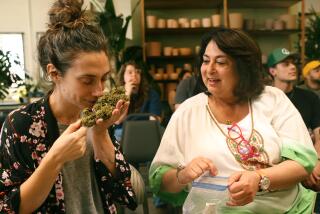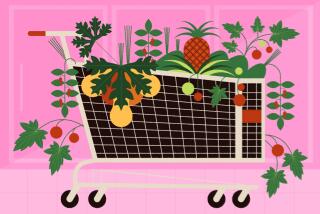Sure, it’s autumn — but you can keep planting that garden
Planning a garden for fall can be a tricky proposition. Even though summer is over, October can be the hottest month of the year.
Lauri Kranz, designer of edible gardens, says you can work with the vagaries of autumn by planting for both the heat and the cool. Her palette for fall takes into account hot Santa Ana winds in October as well as chilly nights in November.
In September she sows “a huge amount of beans,” including French green beans, sunset runners, royal burgundy and dragon tongue bush beans. If possible she puts them where summer tomatoes have been.
Along with the beans she puts in giant Mammoth sunflower seeds. They’ll be blooming just about the time the weather starts to turn colder. Another summer favorite there’s still time for is the Sungold cherry tomato. There are other cherry tomato varieties, but Sungolds are as sweet as candy and prolific.
“There’s no time for seeds,” she says. “They have to be seedlings. They love the heat of September and October, and even as it starts to cool down you’ll have them for the Thanksgiving table. It extends the whole tomato season, and you can harvest them by the bowlful.”
She puts them in the hottest part of a garden, preferably close to where summer beans had been growing to take advantage of the nitrogen the beans left in the soil.
A few weeks later, she puts in English green peas, picking a site where either eggplant or peppers were growing. Then in October she sows onions, carrots, broccoli and a rocket arugula variety from Flora Bella Farms — a regular at the Hollywood and Santa Monica farmers markets. The arugula goes in a cool section of the garden. “They germinate well, and then it cools off to prolong the harvest without bolting quickly.”
The arugula seed is available through Kranz’s website, at www.ediblegardensla.com.
::
How to save seeds of beans, peas, tomatoes and other summer produce
Before you rip out that Brandywine tomato that produced so reliably all season, consider saving the seed from the last fruit for a repeat performance next year.
Saving the seed of self-pollinating summer produce isn’t hard, says David King, founder and chair of the Seed Library of Los Angeles. “All the beans, tomatoes, lettuce and peas — as long as they’re not hybrids, you can save the seeds with impunity.”
Let the fruit from a disease-free plant mature past its prime on the vine and then harvest. For tomatoes, squeeze the juice and seeds into a small bowl. Lightly cover and let it sit for a few days until a scum develops on the surface. Drain this off, rinse and cover seeds with water and discard any floaters that come to the surface.
Pour off the water and dry the remainder on a coffee filter or plate for a couple of days. When dry and hard to the touch of a fingernail, store them in a labeled envelope.
Like the winter edibles — kale, cabbage, broccoli — summer favorites such as zucchini and squash easily cross-pollinate and won’t necessarily have seed that is true to the parent.
As for onions, whose seed is notoriously short-lived, do nothing and hope for volunteer plants. “They say it’s easier to leave an onion in the field than keep seed in the house.”
Tomatoes are the most popular edible garden plant, but King says beans and peas are also prime candidates for seed saving. Just leave the pod on the vine until it is dry and brittle. Remove the shell and let the seed air dry. Store in a labeled envelope. Don’t make it airtight.
“The seed is alive,” he says. “It respirates. If you put them in a plastic bag or airtight jar, you can suffocate them.”






